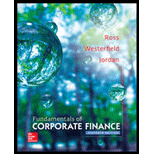
S&S Air’s Convertible Bond
S&S Air is preparing its first public securities offering. In consultation with Renata Harper of underwriter Raines and Warren, Chris Guthrie decided that a convertible bond with a 20-year maturity was the way to go. He met the owners, Mark and Todd, and presented his analysis of the convertible bond issue. Because the company is not publicly traded, Chris looked at comparable publicly traded companies and determined that the average PE ratio for the industry is 12.5. Earnings per share for the company are $1.60. With this in mind, Chris has suggested a conversion price of $25 per share.
Several days later, Todd, Mark, and Chris met again to discuss the potential bond issue. Both Todd and Mark researched convertible bonds and have questions for Chris. Todd begins by asking Chris if the convertible bond issue will have a lower coupon rate than a comparable bond without a conversion feature. Chris informs him that a par value convertible bond issue would require a 6 percent coupon rate with a conversion value of $800, while a plain vanilla bond would have a 10 percent coupon rate. Todd nods in agreement and explains that the convertible bonds are a win–win form of financing. He states that if the value of the company stock does not rise above the conversion price, the company has issued debt at a cost below the market rate (6 percent instead of 10 percent). If the company’s stock does rise to the conversion value, the company has effectively issued stock at a price above the current value.
Mark immediately disagrees, saying that convertible bonds are a no-win form of financing. He argues that if the value of the company stock rises to more than $25, the company is forced to sell stock at the conversion price. This means the new shareholders, in other words those who bought the convertible bonds, benefit from a bargain price. Put another way, if the company prospers, it would have been better to have issued straight debt so that the gains would not be shared.
Chris has gone back to Renata for help. As Renata’s assistant, you’ve been asked to prepare another memo answering the following questions.
1. Why do you think Chris is suggesting a conversion price of $25? Given that the company is not publicly traded, does it even make sense to talk about a conversion price?
Want to see the full answer?
Check out a sample textbook solution
Chapter 24 Solutions
Fundamentals of Corporate Finance
- How do you calculate the intrinsic value of a stock using the dividend discount model (DDM)? i need coarrow_forwardHow do you calculate the intrinsic value of a stock using the dividend discount model (DDM)?arrow_forwardHow does the weighted average cost of capital (WACC) affect a company’s valuation? i need help in this qarrow_forward
- How does the weighted average cost of capital (WACC) affect a company’s valuation?i need correct answer.arrow_forwardHow does the weighted average cost of capital (WACC) affect a company’s valuation?i need help.arrow_forwardHow does the weighted average cost of capital (WACC) affect a company’s valuation? Need helparrow_forward
 Essentials Of InvestmentsFinanceISBN:9781260013924Author:Bodie, Zvi, Kane, Alex, MARCUS, Alan J.Publisher:Mcgraw-hill Education,
Essentials Of InvestmentsFinanceISBN:9781260013924Author:Bodie, Zvi, Kane, Alex, MARCUS, Alan J.Publisher:Mcgraw-hill Education,

 Foundations Of FinanceFinanceISBN:9780134897264Author:KEOWN, Arthur J., Martin, John D., PETTY, J. WilliamPublisher:Pearson,
Foundations Of FinanceFinanceISBN:9780134897264Author:KEOWN, Arthur J., Martin, John D., PETTY, J. WilliamPublisher:Pearson, Fundamentals of Financial Management (MindTap Cou...FinanceISBN:9781337395250Author:Eugene F. Brigham, Joel F. HoustonPublisher:Cengage Learning
Fundamentals of Financial Management (MindTap Cou...FinanceISBN:9781337395250Author:Eugene F. Brigham, Joel F. HoustonPublisher:Cengage Learning Corporate Finance (The Mcgraw-hill/Irwin Series i...FinanceISBN:9780077861759Author:Stephen A. Ross Franco Modigliani Professor of Financial Economics Professor, Randolph W Westerfield Robert R. Dockson Deans Chair in Bus. Admin., Jeffrey Jaffe, Bradford D Jordan ProfessorPublisher:McGraw-Hill Education
Corporate Finance (The Mcgraw-hill/Irwin Series i...FinanceISBN:9780077861759Author:Stephen A. Ross Franco Modigliani Professor of Financial Economics Professor, Randolph W Westerfield Robert R. Dockson Deans Chair in Bus. Admin., Jeffrey Jaffe, Bradford D Jordan ProfessorPublisher:McGraw-Hill Education





